So Pete and I made a video. Again. This time about the new S550 Mustang, because we were both seriously impressed by its fresh new styling, modern 5-link rear suspension, and choice of a 300-hp V6, a high-tech 310-hp 2.3-liter EcoBoost turbo-4, or a howling 435-hp Coyote V8.
That’s a lot of engine options, and when you combine that with its sexy new sheet metal and IRS, there was just no way around the fact that we needed to sample the S550. So we booked both the EcoBoost and GT model from the press fleet and headed to Toronto Motorsports Park to give them a proper shakedown.
Our objective with this track test was simple: if we were to add a new Mustang to our lineup of project cars, which one do we prefer as a starting point for a build, factoring in their off-the-showroom-floor performance as well as price and tuner-friendliness.
I’m not going to waste your time (or mine) repeating what’s already been said in our video (which you’ll find at the bottom of this post), and as you’ll see we cover both cars in a fair bit of detail, so instead I’m going to focus on what we didn’t discuss in much detail and that’s the data I collected using our AiM Solo lap timer and data acquisition system. This thing is a pretty awesome tool for anyone looking to learn more about how their car is performing or how they’re performing as a driver, as you’ll soon see.
| 2015 Ford Mustang GT Premium Coupe | 2015 Ford Mustang Ecoboost Premium Coupe |
| Price as tested: $55,449 CDN | Price as tested: $35,399 CDN |
| Specs: | Specs: |
| 5.0 liter DOHC VCT Coyote V-8 | 2.3L turbocharged inline-4 |
| 11:1 compression ratio | 9.5:1 compression ratio |
| 435-hp at 6500 RPM (93 octane) | 310-hp at 5500 RPM (93 octane) |
| 400 ft-lbs at 4250 RPM | 320 lb-ft at 3000 RPM |
| Multi-port EFI | Direct Fuel Injection |
| 3705 lb curb weight | 3532 lb curb weight |
| Options: | Options: |
| Competition Orange paint | Deep Impact Blue paint |
| Recaro leather-wrapped front seats | Recaro cloth-wrapped front seats |
| 401A Equipment Group including Shaker Audio System | |
| Performance Package including larger capacity radiator, stiffer springs and sway bars, strut tower brace and K-brace, 6-piston front Brembo brakes, 19” wheels with Pirelli P Zero tires (255 front 275 rear), unique stability control, EPAS and ABS tuning | Performance Package including oil pressure and boost gauges, bigger sway bars, stiffer springs, bigger brakes with 4-piston front brakes, black 19” wheels with Pirelli P Zero summer tires (255’s all around), 3.55 LSD rear end, larger capacity radiator, unique stability control, EPAS and ABS tuning |
Oh, but before getting to the in-car data, above is a basic summary of each car’s specs including the options each came equipped with.
THE DATA (BEST LAP FOR EACH)
First of all, it’s worth mentioning that the data below is simply for the best lap I did in each car. I pushed both cars as hard as I could within reason (these are press cars we needed to give back in the same condition we got them, other than a bit of tire and brake wear). It’s also worth noting I’ve done a million laps at this track, so my times here are generally very consistent as I find it easy to find the limit of the tires around this flat, medium speed and low risk circuit. In fact, as AutoGuide.com’s track test driver, I’ve set all the lap times on their Lap Time Leader Board at TMP, so if you want to get a sense of where the S550 GT and Ecoboost Mutangs fall in comparison to a wide range of other press cars, go have a look-see for yourself.
One final caveat is that I’m not a race engineer, just a regular racer-dude with an interest in data acquisition. I’ve read some good books on the subject (I recommend ‘Making Sense of Squiggly Lines’ by Christopher Brown), have learned a few things first-hand from a number of professional race engineers over the last decade and a half of driving at the grassroots and kinda-sorta-(semi)professional levels, but by no means do I consider myself an expert at analyzing in-car data. I am reasonably good at summarizing the basics, though, so here goes.
For starters, here’s a track map of TMP, with right-hand corners shown in orange/yellow and lefthand corners shown in shades of blue. All those data points highlighted on the map are GPS Speed in km/h, with the blue text representing the Ecoboost and the red text representing the GT. As you can see, the GT was hitting 180 km/h down the front straight while the Ecoboost hit 159 km/h. You’ll also notice, however, that the Ecoboost’s exit speed from Turn 1 (at 109.9 km/h) is significantly higher than the GT’s (at 106.4 km/h), and this exit speed advantage is consistent across the lap.
Looking at speed (again in km/h) across a lap in distance mode, it’s easy to see the GT (red line) is accelerating faster and hitting much higher top speeds down each straight away, but you can also see that the Ecoboost (blue line) is carrying a consistently higher speed through each corner (the grey vertical bars are corners). You can also see the blue line for the Ecoboost model starts to climb earlier in each corner, indicating that I’m back on the gas sooner.
From the driver’s seat, the delay in getting back on the throttle in the GT stems from the fact that it has a fair bit of turn-in understeer, so you have to be patient with the throttle or you’ll just induce more of it (unless you really stomp on it and overpower the understeer with oversteer). In the video I speculated that a wider front tire would help reduce turn-in understeer and I stand by that statement, but as a YouTube commenter pointed out the S197 Boss 302 doesn’t have a wider front tire as I stated it did in the video.
The Boss actually has the same staggered tire sizes as the GT (255’s front and 275’s rear), so the greater willingness of the Boss to rotate must come from its spring and bar rates as well as its differential. The Boss 302 I tested had a clutch-type limited slip differential with some pretty aggressive lockup characteristics, while the new Mustang GT has a milder Torsen (gear-type) LSD, so my suspicion is that a big part of the handling difference stems from the differential.
You’d think the Ecoboost’s cornering speed advantage would translate to higher cornering g-forces as well, but that isn’t the case when looking at peak values. In the friction circle diagram above, you can see the GT (red data points, with left/right of center representing lateral or cornering g-forces and up/down representing longitudinal or braking/accelerating g-forces) is actually pulling higher g’s at the extreme left and right of the graph where cornering g-forces are strongest.
However, the Ecoboost (the blue data points) is “filling out the circle” better in the trail braking zone in the bottom left and right quadrants between +/- 0.4 and 1.0g along the x-axis, further emphasizing that the Ecoboost is better balanced on turn-in and allows the driver to get back on the gas sooner. This is certainly how the Ecoboost felt to me in the driver’s seat, and the data supports that feeling.
Looking at lateral or cornering g-forces across the lap in “over distance” mode, you can see the Ecoboost (blue line) is getting its cornering done earlier, so although the peak g-force figures are similar to the GT (red line) though often a bit lower, the Ecoboost Stang is clawing back time in every corner because it’s better balance allows the power to be applied sooner.
If you look at the sub-graph along the bottom of the above image, it shows you where the Ecoboost is falling behind (blue rising line) vs the GT’s baseline (the red flat line along the very bottom), and as you can see in the grey cells that indicate corners the Ecoboost is closing the gap in every corner but losing big chunks of time down the straights because it’s so out-gunned by the 5-liters of V-8 goodness under the GT’s hood.
TMP is also a track that puts a big emphasis on braking, and in this area neither car has much of an advantage. The GT does spike higher braking g-forces (as indicated by the troughs on the red line), particularly in Turn 1 where it quite impressively pulls over 1g on the brakes, but you can also see I’m having to spend more time on the brakes in the GT. This, of course, is partly due to the higher straight away speeds the GT can achieve thanks to that big, juicy V-8 engine, but it’s also due to its 3705 lbs curb weight.
Neither car suffered from brake fade, which is quite unusual for an OEM braking system at this track with its many heavy braking zones, so props to Ford for equipping both cars (with Performance Packs) with track-worthy brakes. The pads in particular have a lot of initial bite and excellent torque as you add braking force, which is surprising from an OE part but shows you how committed Ford is to making these cars truly track-ready when equipped with the Track Packages.

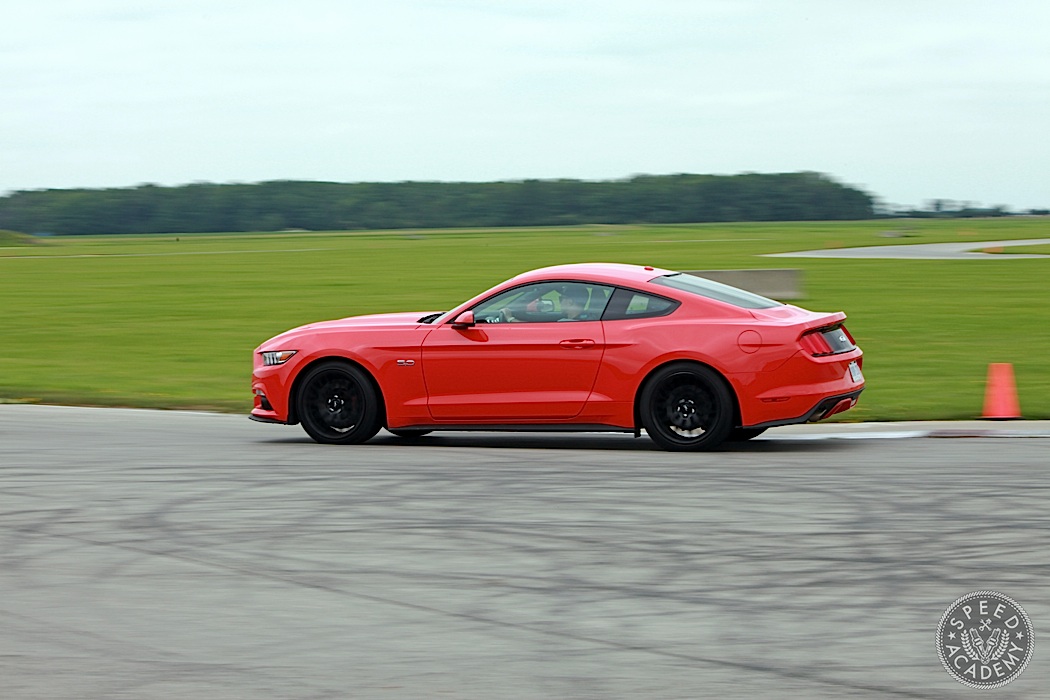
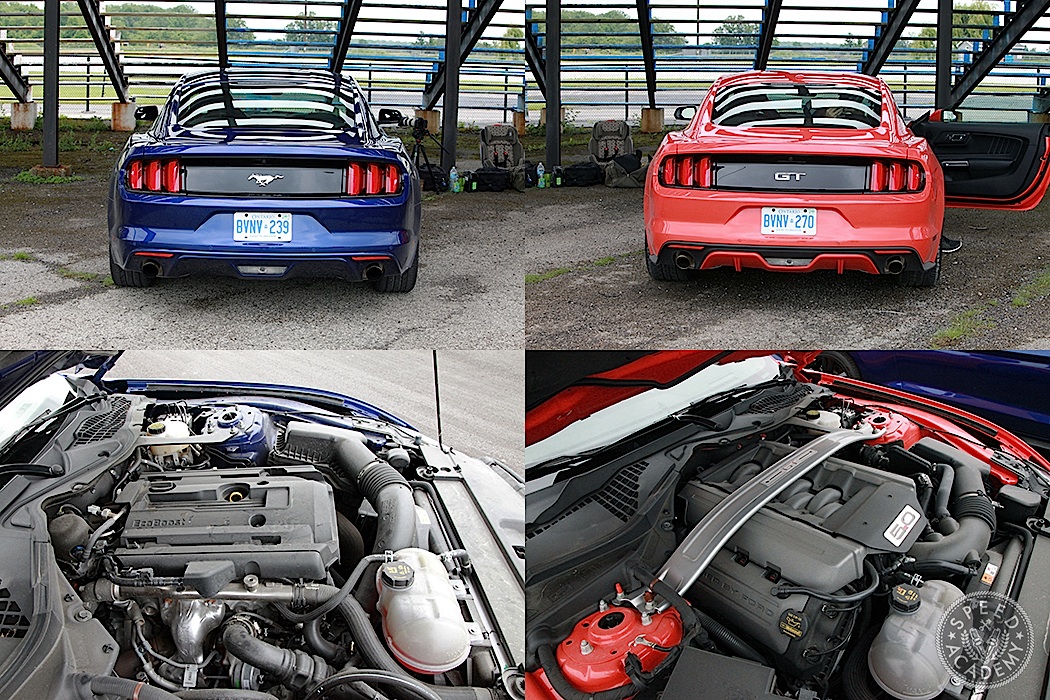
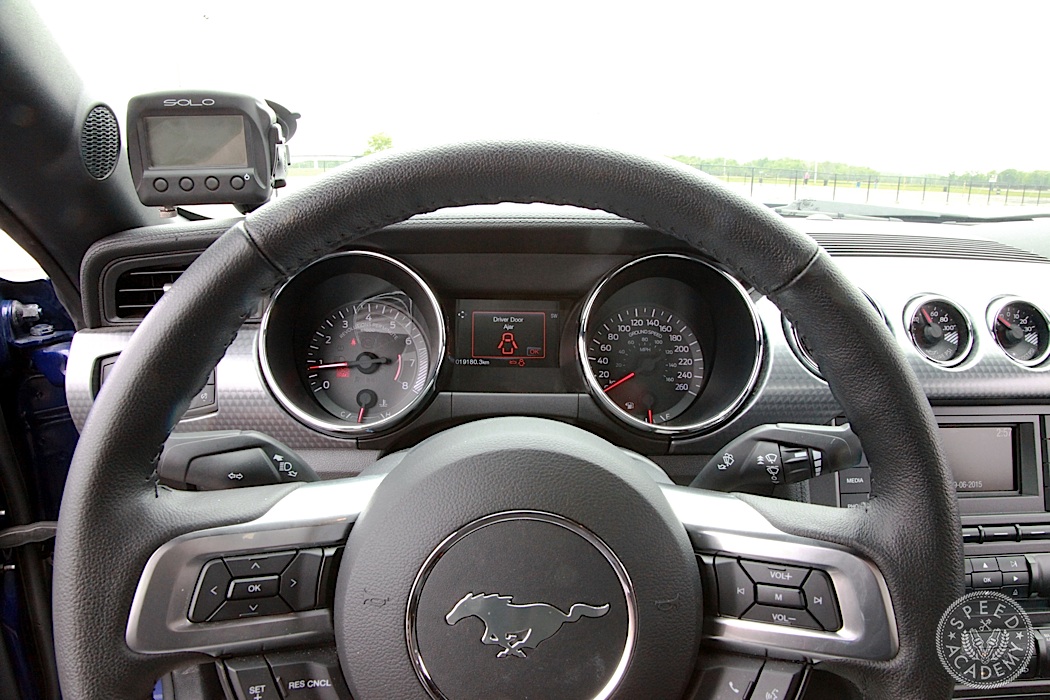

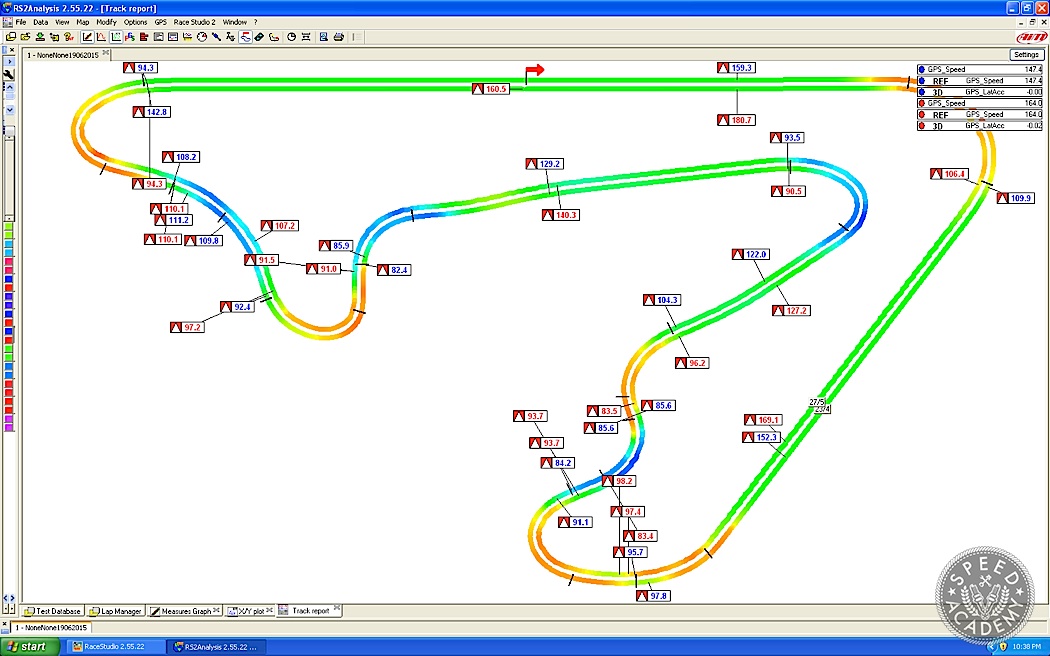
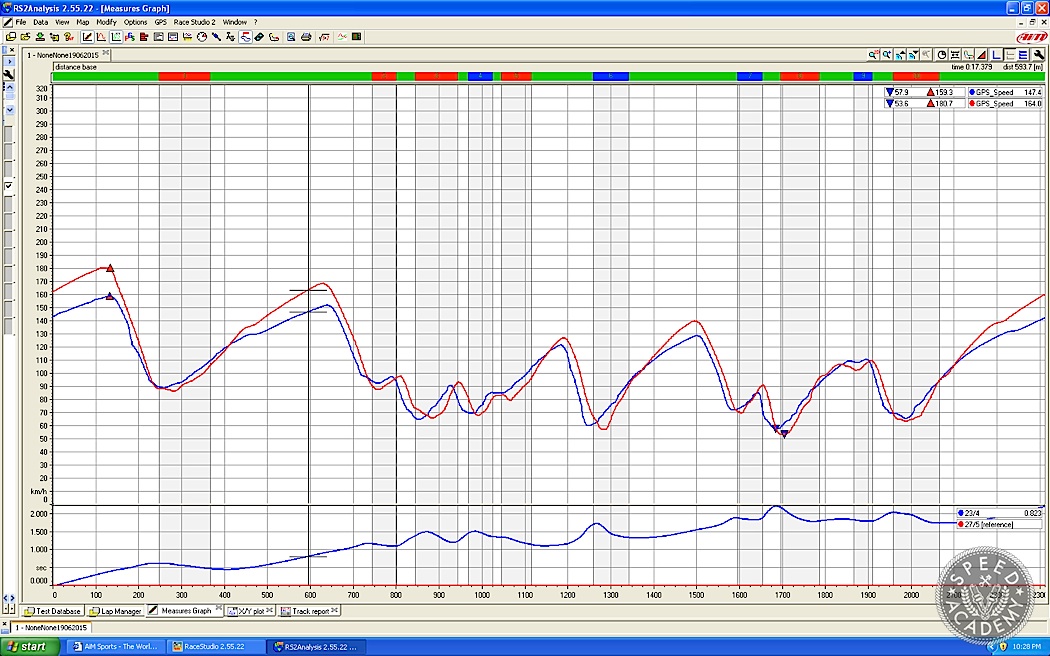
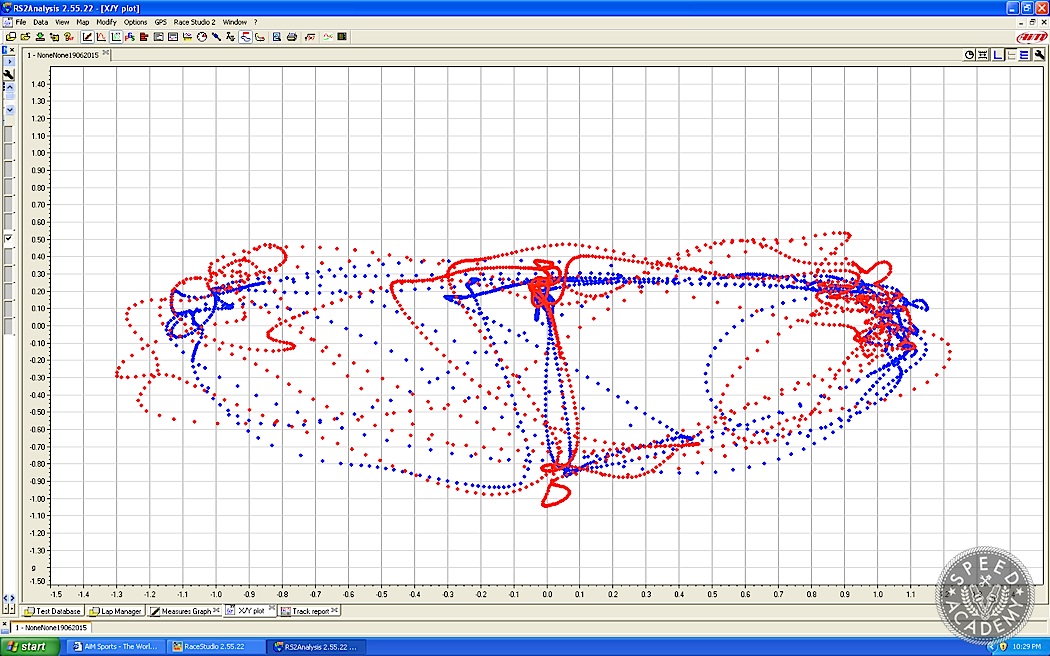
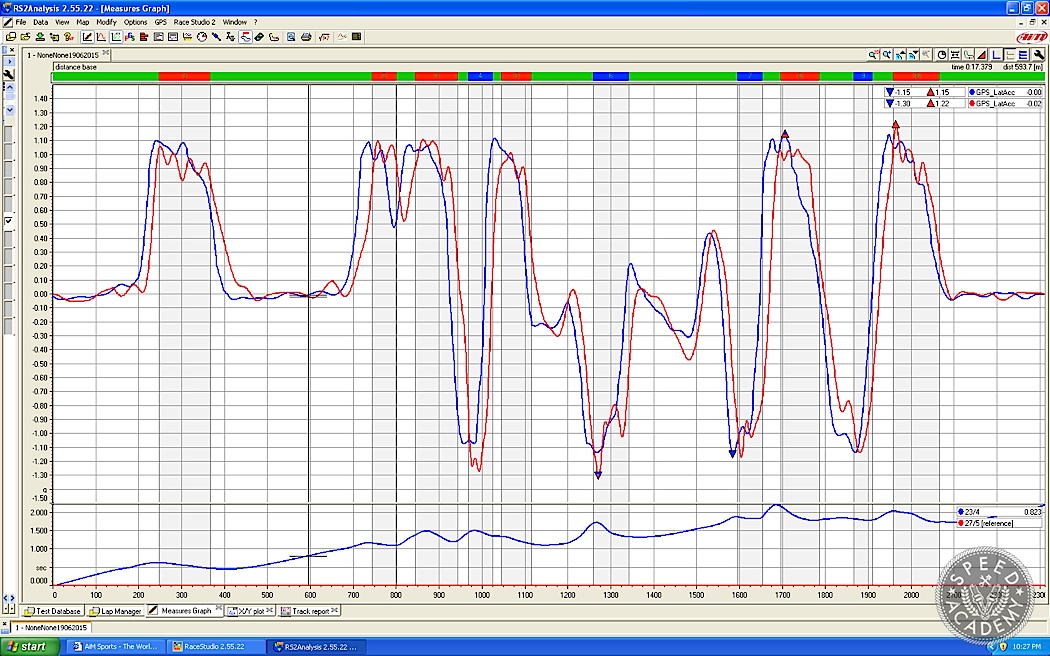

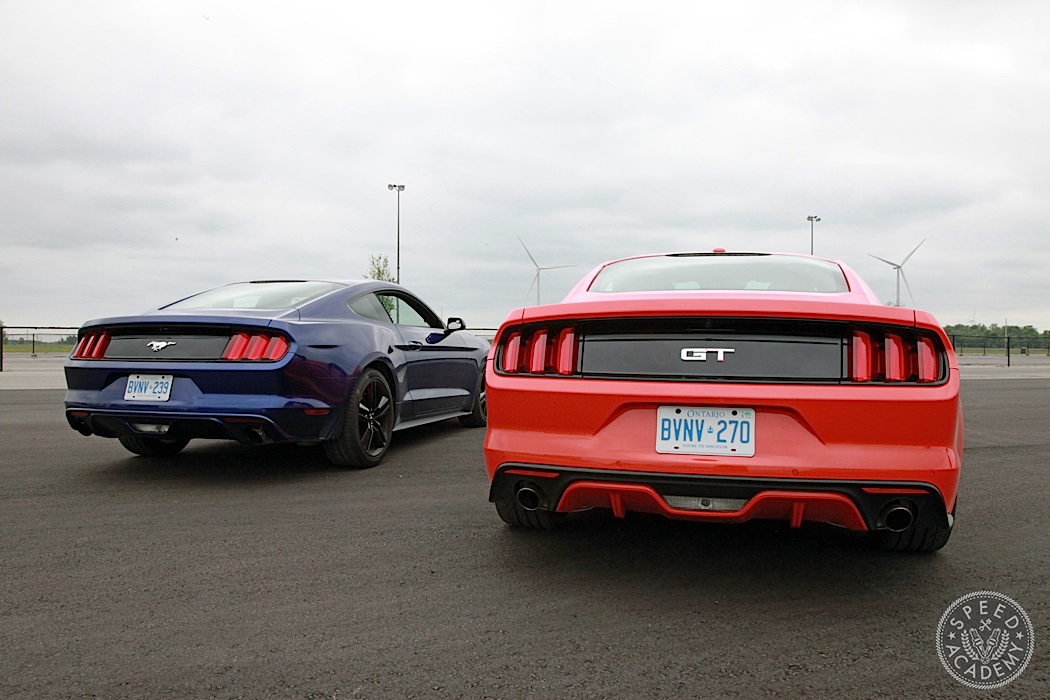
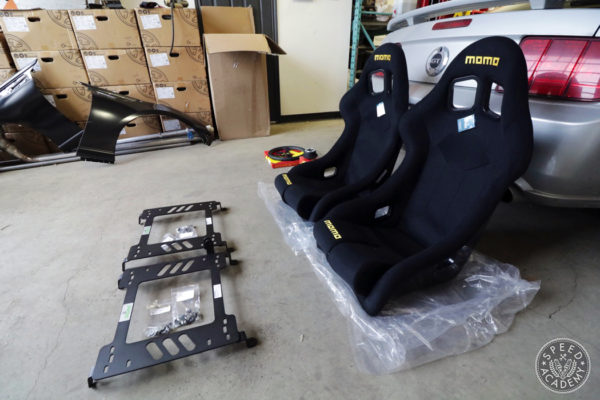
What an incredibly in-depth test. Thanks for not just posting the lap times, but taking time to post telemetry and explain the subtle differences between the drivetrains. Wonderful read, please keep them coming!!
Great to hear you liked the story! We’re trying to do more tests like these in the near future.
Ecboost keeps impressing me… I wonder if the GT will decrease in relevance when the Focus RS comes out.. more power, AWD…
Great question. They’re very different cars one being a 2-door sports coupe the other a hatchback so I’m not sure whether there will be that much cross shopping but if I had a choice you can put me down for a Focus RS over the GT.
Thanks fellas! We do what we can to offer our readers some in-depth insights without putting you completely to sleep 😉
TokyoR, the Focus RS is going to be a giant killer, for sure. Not sure it’s really the type of car too many Mustang GT owners will be interested in, since it’s a smallish hatchback with a smallish turbo engine and AWD. Still, I bet it’ll give the GT a serious run for its money around a race track. Plus: drift button!
Quite the comprehensive article. I am actually excited to see whether or not Ford brings back the Fusion ST with the 2.3 turbo mill. I am looking for the fun factor yet having the 4 doors for convenience. My family has found the Fusion to be comfortable and enjoyable as a 2 week rental with the 1.5L turbo model so a more sport tuned variant that would bring it in line with the performance ticks of the Mustang and new RS would have to be a hoot.
AdrianTauer How about a Focus ST? It’s surprisingly spacious and has that potent 2.3L turbo motor you’re after. Hatchback practicality with 4 doors and a high grade interior. It’s an impressive package and I’ve tested them at our local track and they’re very quick. Fastest FWD press car I’ve ever evaluated there.
How about long term reliability for the ecoboost? Do you guys believe it will hold its ground?
That’s a great question. I’m not sure how reliable the 2.3L Ecoboost engines have been so far, especially when guys turn up the boost and make other upgrades to them. I’ll ask our friends over at Full-Race, who work with these engines a lot and get back to you on that.
So Dave, what did you find out about the Ecoboost reliability in the long term?
We haven’t been able to do any long-term testing with an Ecoboost engine. We do understand there have been some reliability issues with the F150 3.5L Ecoboost engines as well as the Focus RS losing head gaskets, but not sure how common these issues really are. It’s tough to gauge on the Internet, since the vocal disgruntled minority can often make it seem like the problem is more widespread than it really is.